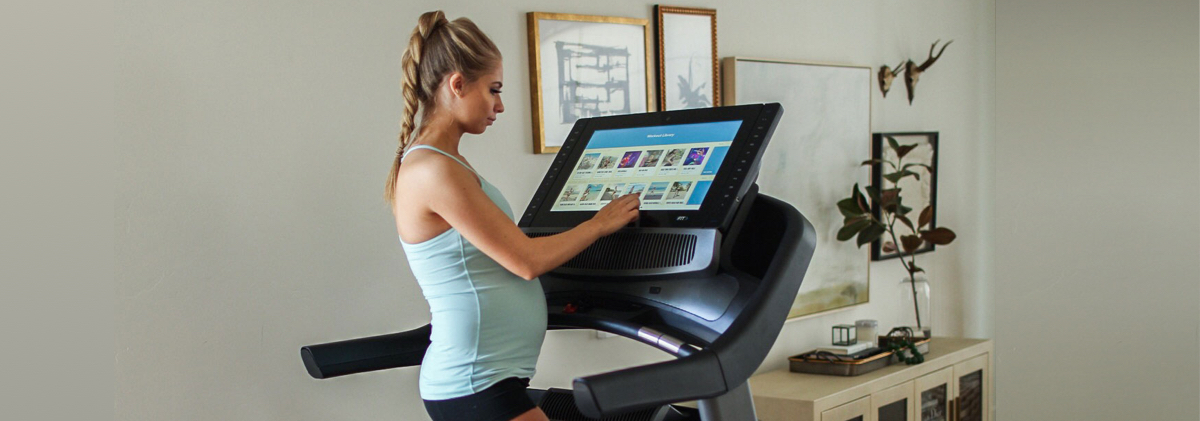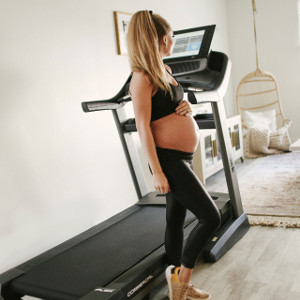
Pregnant women, especially first-time moms, face the complicated obstacle of maintaining physical activity during their first, second, and third trimesters. Whether or not exercise is safe will vary from one pregnant woman to the next with a multitude of factors playing a role in the final decision.
From walking on the treadmill while pregnant to maintaining a weightlifting routine, each woman will have different needs and cautions. But we’ve gathered a few general tips from experts online to set the foundation for safe prenatal exercise.
1. Exercise earlier in pregnancy to experience fewer discomforts later in pregnancy.
This expert tip comes from the Medicine and Science in Sports and Exercise journal. During a clinical trial in the early 1990’s, researchers found little correlation to exercise and birth weight, pregnancy outcomes, and gestational age. However, they did find a significant outcome concerning a decrease in later pregnancy discomfort in relation to the earlier exercise intervention.
Getting past the nausea phase might be tricky but once you’re in the clear, implement a regular workout routine. It doesn’t have to be extreme. A simple 30-minute session a few days a week can make a huge difference compared to sitting for the last 6 months of your pregnancy.
Check out the Fit Mommies workout program with iFit®. Personal trainer Elise Miller will take you through a total of 12 workouts that consist of yoga, cardio, and toning exercises.
2. Avoid physical activity that creates a higher risk of falling (and scuba diving).
The American College of Obstetricians and Gynecologists recommend re-evaluating a woman’s overall health before establishing a new workout regimen during pregnancy. Obstetric and other medical risks increase with pregnancy. While there is a long list of physical activities that are completely safe for pregnant women, any activity that runs a high risk of falling or abdominal trauma should be avoided. Additionally, these experts also say to forget about scuba diving during pregnancy — just in case you were considering it.
3. Hitting the treadmill when you’re expecting gives your unborn babes a mental boost.
Researchers from Dokuz Eylul University in Turkey have determined that using the treadmill while pregnant has a positive effect on your new off-spring. It’s shown to decrease anxiety and increase prefrontal cortex VEGF and BDNF levels in your child.
4. Expect to gain weight, no matter how hard you exercise.
There are multiple studies that have shown a similar result, but this specific study in the Canadian Journal of Applied Sport Sciences sums it up really well. Researchers monitored 33 runners and 11 non-runners throughout their pregnancies and found no significant differences in weight gain.
No matter what level of athleticism you maintain during your pregnancy, weight gain should be expected — even more, it’s perfectly healthy! The CDC says that a healthy weight gain during pregnancy can be anywhere from 11 to 62 pounds, depending on your normal non-pregnancy weight and if you’re pregnant with twins.
5. Support the tummy with a belly band.
While many activities are still a-ok when you’re expecting, they may add more discomfort around the midsection than you anticipated. But the right support can help you to go a little further, more comfortably.
“Wear a belly band to help take some weight off around the ligaments and give your back and belly more support.”
Erica Ziel, personal trainer and founder of Knocked-Up Fitness Prenatal DVDs.
6. Certain health conditions make exercise during pregnancy a bad idea.
Any level of exercise, including walking, can cause serious health conditions for mom and baby during pregnancy. These include preeclampsia, bleeding in the second or third trimester, lung or heart disease, and placenta previa.
Always consult your doctor before making any changes to your daily activity or fitness routine while pregnant.
7. Stop if it hurts (and more warning signs to look out for).
While many women can safely exercise throughout their pregnancy, there are certain symptoms to pay attention to. These red flags are telling you to cool it and perhaps it might be time to call your doctor.
- Difficulty breathing
- Dizziness
- Chest pain
- Irregular heartbeat/palpitations
- Tightening in the tummy/cramping
- Water breaking
- Vaginal bleeding
- Pain around the tummy
- Pain in the pelvic area
- Exhaustion
- Headache
- Weak muscles
- Trouble standing
- Pain or swelling in the legs
In conclusion, exercising while being pregnant can not only benefit your health but also your baby. Make sure to always consult your doctor before developing any form of exercise routine, and remember that every pregnancy is different. What may work for you may not work for someone else.
DISCLAIMER: This post is not intended to replace the advice of a medical professional. The above information should not be used to diagnose, treat, or prevent any disease or medical condition. Please consult your doctor before making any changes to your diet, sleep methods, daily activity, or fitness routine. NordicTrack assumes no responsibility for any personal injury or damage sustained by any recommendations, opinions, or advice given in this article.
Sources:
https://www.nordictrack.com/treadmills
https://europepmc.org/abstract/med/7674866
https://www.ifit.com/daily/555635be1cbd21ef7f444907
https://www.nordictrack.com/learn/ifit-help-get-started-ifit/
https://www.ncbi.nlm.nih.gov/pubmed/12808399
https://www.sciencedirect.com/science/article/abs/pii/S0304394012004892
https://europepmc.org/abstract/med/7105378
https://www.cdc.gov/reproductivehealth/maternalinfanthealth/pregnancy-weight-gain.htm
https://www.parents.com/pregnancy/my-body/fitness/pregnancy-friendly-treadmill-tips/
https://blog.nasm.org/fitness/exercise-pregnancy-physiological-changes-exercise-programming/



